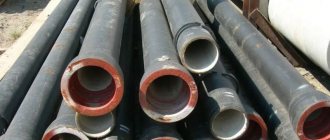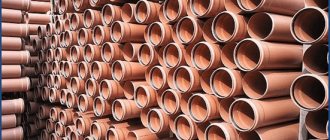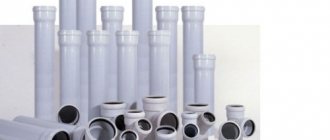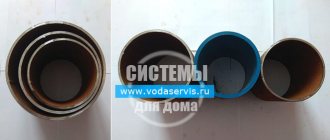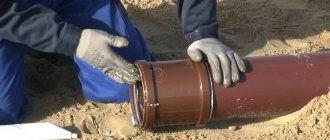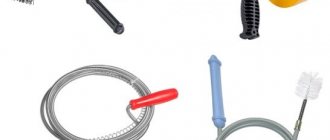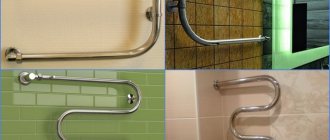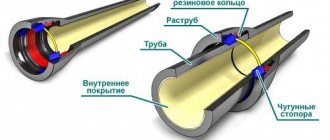What is sealant for sewer cast iron pipes and how to choose the right material for sealing joints? One of the main tasks facing the master at the final stage of construction is to prevent leaks that appear in the sewer system.
Sealant for sewer pipes is a special composition that protects joints from leakage. In addition, it provides ease of installation and helps cope with emergency situations. In this article we will look at what types of sealing substances there are for PVC pipes and cast iron channels.
When is sealing of sewer pipes required?
Often the sewer riser or outlet parts of a cast iron pipe receive serious damage. An inspection shows that a piece of the cemented patch is falling off, and the pipe itself may fail. In this case, the master decides to use sealant for cast iron sewer pipes or PVC plastic pipes. During the work, the recommendations specified in SNiPs and technical regulations, pipe wear, hydraulic effects and the possibility of leaks are taken into account.
Sealant for sewer pipes must be selected taking into account the fact that this external sewer has a significant diameter and a large length.
Sealing PVC sewer pipes is necessary to prevent sewage from entering the apartment and eliminating unpleasant odors in residential areas.
Scheme for sealing a pipe joint
Solving the problem of sealing joints must be taken quite seriously.
Having identified the cause of the malfunction that is interfering with the operation of the cast iron pipe, the owner can carry out the entire cycle of necessary work to eliminate it.
The causes of pipe leaks are varied:
- defect in the material used to install the sewer;
- improper laying of cast iron sections;
- the presence of cracks and holes in the riser.
The purpose of sealing system elements
The sewerage system is reliably sealed during the installation stage. During operation, the internal system is regularly inspected in order to detect and eliminate leaks in time.
Wastewater should not flow out, and nothing should get into the sewer system from the outside, because... this can disrupt its operation and lead to serious damage.
Particular attention should be paid to sealing pipes laid underground, as they are much more difficult to repair if leaks occur. If the operation of the system is disrupted due to groundwater entering it, a lot of effort will have to be made to determine this.
Repairing the underground part of the sewer system is almost as labor-intensive and expensive as installing a new section of pipeline. It involves a large volume of excavation work, replacement of damaged system elements
Careful sealing during the construction phase of the sewer system prevents a number of problems:
- Leaks to the outside. Once in the soil, wastewater can contaminate water in drinking wells and cause serious illnesses. The unpleasant smell of sewage in premises is also dangerous, because... rotting organic matter releases gases harmful to humans: hydrogen sulfide, ammonia, methane.
- Flooding of buildings and structures. In case of severe leaks, soil erosion may occur. Sewage water floods foundations, cellars, cellars, and basement floors. Due to the high content of chemically active substances, they accelerate the destruction of building materials and provoke corrosion.
- Leaks into the system. If atmospheric or groundwater enters the system, the pressure in the pipeline increases. Due to the strong pressure of wastewater, the operation of pipes is disrupted, and treatment or storage facilities may not be able to cope with the additional load and fail.
- Leaks at joints due to temperature changes. If the system is initially installed efficiently, the joints are reliable and do not leak even without additional sealing. However, processing is still necessary, because Temperature changes over time lead to a decrease in tightness.
Various types of pipes are used to install sewerage systems. A suitable sealant should be selected for each pipe material. The choice also depends on the installation technology and the intended purpose of each individual element of the system.
Types of sealants
Sealing of sewer pipes can be done with the following materials:
- reinforced aluminum adhesive tapes;
- silicone sealants;
- mastics from various manufacturers;
- polymer cement solutions;
- sanitary winding;
- epoxy resin;
- technical sulfur.
To choose the right sealant for sewer pipes, you need to know the material from which the drain is made. Silicone compounds and reinforced tapes are suitable for lightweight plastic pipes PVC, PEX, HDPE, etc. If you have to work with metal (steel or cast iron), you need to use something serious. It is also important to consider for what work the solution is purchased.
The joints of PVC plastic pipes are sealed with lightweight silicone, which is unlikely to cope with an emergency leaking sewer. It is also important to follow the instructions. It describes the optimal conditions under which sewer pipes should be sealed. For example, let's take the optimal conditions for curing silicone sealant (this is room temperature, at which it dries for about 4 minutes). When working in cold weather, the hardening time is significantly longer.
There is a need to purchase another type of sealant - frost-resistant silicone. We'll talk about the nuances of using different materials below.
Materials. What is the name of the thread for sealing pipes?
3.1. List of materials used
Sealing of pipe joints or sockets is carried out using:
- self-adhesive tape (regular and foil type);
- silicone sealants;
- anaerobic sealants;
- gels, pastes;
- epoxy resin;
- sulfur for technical purposes;
- bitumen mastic;
- winding record;
- fluoroplastic sealing material, etc.
Effective means are a rubber seal (especially for standard sewer pipes) and sealing the pipes with flax (tow with solutions made from red lead and drying oil or Portland cement). The latter remedy is used to seal large diameter sockets.
Another very important tool often used by plumbers is plumbing thread (or, as it is also called, thread for sealing pipes)
3.2. Self-adhesive tapes
The product is one of the newest in the field of use for sealing pipe joints.
It is different:
- good anti-corrosion characteristics;
- high quality sealing;
- efficiency in use;
- ease of use;
- long service life, since they are produced on a high-strength polyethylene base;
- breadth of application.
Using self-adhesive tape, you can not only efficiently seal a sewer pipe, but also use it when installing plugs, turning corners, bends, couplings, valves, and other elements of pipe fittings.
When carrying out sealing, the following algorithm should be followed:
- prepare the surface. To do this, you need to clean it from dirt and wipe it well;
- when winding the film onto a joint, it is necessary to maintain constant tension in order to avoid possible folds and unevenness;
- The material must be wound in a spiral with an overlap, approximately half its width, so that the entire surface necessary for insulation is under two layers of material.
Important! Self-adhesive tape is protected from ultraviolet rays. In order to ensure a long service life, it is recommended to wrap another 1-2 protective layers of other material over the tape.
3.3. Silicone based sealants
Any silicone sealant based on rubber is made. Thanks to the presence of various substances, reliable, long-term sealing and good adhesion to the surface are ensured.
It is best if the future sealing areas are pre-treated with a primer. The hardener determines the type of sealant and the polymerization time.
According to this classification, sealants are:
- neutral;
- acidic, characterized by chemical resistance and relatively low price.
Silicone sealants can be used to seal both cast iron pipes and plastic risers.
After polymerization, the paste becomes rubber-like.
Important! It is best to use a special mounting gun when working with sealants. Thanks to it, the paste is squeezed out smoothly, easily, in the required quantity.
3.4. Tow
This material, together with lead lead on drying oil, for decades has been and will remain one of the most reliable among many other analogue sealants.
Thread with wound tow
Using flax strands, gas, heating, and plumbing structures were installed in the vast majority of apartments and private houses.
Important! The use of red lead makes it possible to prevent the occurrence of corrosion processes, which cannot be said about the iron analogue. The main advantages of sealing with tow:
- reliability;
- ease of installation. In order to make a high-quality seal, it is necessary to wrap tow on the external thread, generously coat the material with red lead and tighten the fitting thoroughly. After this, you need to tighten the locknut. Simple, reliable;
- accessibility, minimal financial costs;
- ensuring a high level of adhesion;
- the presence of strong fixation of connections after tightening with a gas (pipe) wrench.
Flaws:
- in order to correctly install the connection and the pipe as a whole, you must have a sufficient level of professional knowledge;
- applying too much force when tightening may cause damage to threads and fittings;
- the complexity of dismantling work, which can lead to heating of individual components in order to replace them with others of better quality;
- the need to monitor the condition of the system, since over time the strands lose their original properties, which can lead to gas leakage.
Self-adhesive tapes and their properties
The structure of the sealing tape
This type of sealing can be used both to seal and protect joints, and to strengthen sealing plugs, fittings, taps, corners and elbows. The main advantage of the tape is its ease of use. It is wrapped in several layers around the pipe on the desired section of the sewer. This ensures reliable and long-term operation of the system, protection against corrosion and the effects of currents, and waterproofing of joints. Depending on the composition, adhesive tape can be used both on cast iron sewer pipes and on plastic, such as PVC or PE (HDPE) pipes.
The tape must be applied to a dry surface. Before winding, the pipe is cleaned of dirt and liquid and degreased. Next, we wrap the problem area with an overlap so that the previous round overlaps the new one by half the width. We keep the tape under tension and do not create folds.
As for the choice of insulating material, special anti-corrosion tape coatings should be used. They are used to seal joints between pipes, seal coupling units, tie-ins, and bends related to the sewer system.
What is a sealing tape that insulates a sewer pipe? The product is based on a bitumen-rubber mixture and a protective film.
The peculiarity of the material is that it has a high degree of strength, is used to work with various compositions, and does not collapse for a long time.
You can avoid the unpleasant consequences of a leaking sewer riser by sealing the joints with a silicone compound. For work, 2 types of materials are used:
- acid insulation;
- neutral sealant.
Repairing defects using a neutral compound will cost the owner much more than working with acidic insulation.
The use of silicone is economically beneficial, since the material has significant adhesion.
As for the use of other sealing compounds, here you can choose the following types:
- bitumen mastic;
- cement mortar;
- asbestos cement composition.
Helpful tips for proper use
Experts make the following recommendations:
- Before applying plumbing sealant, the surfaces must be completely cleaned of any grease or residue from the previous solution. Otherwise, the composition may move away from the threads or begin to crumble if solid dirt particles get into it.
- The amount of winding is determined experimentally. There should not be too much of it so that the parts can fit into each other. But if the quantity is insufficient, water leaks may occur.
- Brass and bronze pipes are very fragile, so be careful when tightening them.
- Before putting the water supply system into operation, the water pressure is started in test mode.
We recommend videos on the topic:
Silicone sealant
Sealing of joints is carried out using silicone adhesives made in accordance with TU 6-15-1822-95, GOST 6-02-4-53-96.
All plumbers have a weakness for this type of sealant. Meanwhile, silicone compounds have good sealing ability, allow you to seal seams and cracks in plastic and cast iron pipes, dry quickly and are easily removed from the surface.
There are two types of silicone compounds.
- The first type, neutral , allows you to work with any surface and does not come into contact with water and other substances. Features a higher price tag.
- The second sealant, acidic , is used only for PVC pipes and other plastics. Although it is a cheap substitute, it destroys metal and cement-containing materials. In the presence of water, it breaks off acetic acid, which can damage the inside of pipes. Therefore, for cast iron and steel pipes we choose only neutral sealant.
Silicone insulating material is a rubber-based composition consisting of a filler, a hardener and a catalyst. The vulcanization temperature of the material ranges from +60 to +200˚С.
Stages of sealing cast iron pipes with sealant
Silicone sealant for repairing PVC pipes in the sewerage system has a density of 2.0 g/cm³, dries at a temperature of +20˚C in 150 minutes. The tensile strength characteristics are even more varied, ranging from 16 to 20 kgf/cm² and depending on the grade of material.
The peculiarity of the sealant is that the vulcanizer has high adhesion to steel, copper, aluminum, silicate glue, and concrete. Silicone sealant is resistant to adverse weather conditions, solvents, synthetic and mineral oils.
When repairing a pipe, there is no pollution of the environment with toxic substances, since silicone materials belong to class 4 of low-hazard products. The sealant is used for gluing and sealing joints and connectors when repairing sewer pipes.
Materials intended for sealing
Sealing tapes
Both regular and foil tapes are available
Self-adhesive tapes, which have anti-corrosion properties and are specifically designed for sealing pipe joints, are one of the newest modern means of sealing. They have many positive properties:
- Self-adhesive anti-corrosion tapes are quite highly effective and easy to use.
- Sealing films, thanks to their high-strength polyethylene base, are characterized by good operating properties.
- They are used to provide protection for various types of pipelines as a whole, as they have dielectric and anti-corrosion properties. In addition, sealing films are used to seal linear elements of sewer pipes.
- Sealing using tape is possible not only when sealing the joints of sewer pipes, but also when sealing plugs, taps, turning corners, bends, etc.
Before sealing a sewer pipe using sealing tapes, remember that sealing is carried out in the following sequence:
- To apply the tape, surface preparation is necessary: it must be dry, dust-free and clean;
- it is necessary to ensure constant tension of the tape that is wrapped around the pipe, and also to prevent the appearance of folds and wrinkles;
- the tape must be applied, providing an overlap of 50%, in a spiral, as a result of which the entire surface to be insulated will necessarily be under two layers of film.
Sealing sequence (some tapes require primer treatment)
Pro tip:
Such films are not resistant to UV radiation. That is why, when placing sewerage pipes in an area that is exposed to the sun, an additional protective layer must be provided over the film.
Silicone sealants
Silicone is the most well-known material for sealing
Silicone rubber forms the basis of silicone sealants. Silicone sealants in general are a composition of different substances that provide high sealing qualities. Silicone sealants have good adhesion to surfaces, without requiring them to be pre-treated with primers.
Based on the type of hardener in its composition, sealant for sewer pipes made of silicone is divided into:
- Acid. Acidic silicone sealants are quite inexpensive, although they cannot be applied to some surfaces that can interact with acids.
- Neutral. In this regard, neutral silicone sealants are considered more universal.
Using silicone sealants, it is possible to seal the joints of sewer pipes:
- made of metal;
- made of plastic.
After vulcanization, the silicone paste turns into a substance that is similar in properties to rubber. The vulcanization process of silicone sealant involves moisture in the air.
Pro tip:
Squeezing out the sealant is quite simple - using a mounting gun. If it is not available, you can use an ordinary hammer by inserting its handle into the tube and pressing as if on a piston.
How to squeeze out silicone sealant without a mounting gun
Sealing sewer pipes with other sealants
In addition to the above means, sealing sewer pipes is also done using other means:
- Epoxy resin - at home, like glue based on it, serves as the most common means used for connecting sewer pipes.
- Portland cement is a fairly common component of most sealing mixtures - it is used in the preparation of asbestos-cement mixtures and when caulking the socket joints of cast iron sewer pipes.
- Petroleum bitumen and asphalt mastic will be required to prepare the fill, which is intended for sealing joints and filling sockets of ceramic pipelines.
- Hemp or jute rope, resin strand - are used when sealing the sockets of cast iron and ceramic sewer pipes. Using a combination of rope and resin impregnation would be preferable.
- Technical sulfur - is used to ensure tightness, mainly at the joints of cast iron sewer pipe sockets. Before pouring it into the joint gap, it should be crushed and then heated until melting.
Technical sulfur can also be purchased in crushed form.
With such an abundance of materials, the question is unlikely to arise: “How to cover a sewer pipe?”
Technical sulfur
Sealing an old cast iron drain can be very difficult. Technical sulfur was often used to repair cast iron pipes. But to apply it, it was necessary to heat the composition to a plastic state. A special vessel was used (bath for heating sulfur).
The material is pre-melted in an electric furnace at a temperature of 130-135˚C, and then poured into the socket. Unfortunately, the repair may be of poor quality if it was not possible to fill it at once.
Observing special precautions will help you avoid unpleasant consequences when working with sulfur, since the sealant easily spills, and careless handling leads to a chemical burn.
In addition to the high temperature and risk of fire, there was another risk factor during such work - toxic gas was released during combustion. Therefore, I had to work in a respirator. Nowadays, pipes can be sealed in safer ways, so technical sulfur is practically not used.
Cast iron pipes
When listing the types of metal pipes used for the installation of sewerage systems, one cannot fail to mention cast iron products. Since cast iron pipes have been the main material for assembling sewer networks for decades. The main advantages of this material are:
- Durability and long service life;
- Corrosion resistance.
The disadvantages of the material include:
- Heavy weight, which makes it difficult to transport the material and install it.
- Relatively high fragility. Cast iron pipes do not withstand shock loads well.
- It is impossible to use for laying an external pipeline in saline soils, since soil brine quickly destroys the material.
- Rough inner surface, which causes pipes to clog faster.
Asbestos cement pipes
To produce such pipes, a mixture of asbestos fiber and Portland cement is used. Advantages of these products:
- Resistance to corrosion processes.
- Simplicity of machining, which greatly facilitates installation.
- Long service life.
- Smoothness of the inner surface.
- Asbestos cement is a dielectric, so this material is not subject to electrochemical corrosion.
Asbestos-cement pipes have disadvantages, these are, first of all:
- Fragility of the material. When working with pipes made from asbestos cement, you have to be extremely careful and careful.
- Under the influence of soil, the outer surface of the pipes quickly collapses, so protective measures must be taken.
Ceramic pipes
Ceramic pipes resemble cast iron pipes in their properties, however, they are lighter and one hundred percent resistant to corrosion. The undoubted advantage of ceramic pipes is their resistance to high temperatures and aggressive environments - acids and alkalis.
However, the material is quite fragile, so you need to handle the pipes carefully during loading, transportation and installation. In addition, mechanical processing of pipes (cutting) is difficult; if you try to cut the pipe, it may simply split.
Pipes made of polymer materials
Today, various types of plastic pipes for sewerage are widely used. For the manufacture of such products, three types of polymers are used:
- Polyvinyl chloride.
- Polypropylene.
- Polyethylene.
PVC pipes are designed for gravity sewer systems. The material is quite durable and can withstand high loads. PVC pipes are widely used for the installation of external systems, as they are inexpensive, can withstand aggressive environments, and are resistant to ultraviolet radiation. But pipes cannot withstand exposure to temperatures above 70 degrees; at very low temperatures, PVC becomes brittle, so it is recommended to insulate them.
Various types of polypropylene pipes are widely used for assembling sewerage systems. These pipes have a long service life and can be used for both gravity and pressure systems.
It is necessary to distinguish between the types of propylene pipes intended for internal and external pipelines. The first type of pipes was created for use at home; they are quite durable, but are not able to withstand the effects of low temperatures and loads exerted by the soil.
For external pipelines, special types of pipes are produced - two-layer ones. Their inner layer is perfectly smooth, and the outer layer is corrugated, so the pipes are characterized by increased strength.
When assembling sewerage systems, different types of polyethylene pipes are increasingly used. This material is mainly used for the installation of non-pressure systems. The great advantage of this material is its high elasticity; when the liquid in the pipe freezes, the polyethylene does not collapse, but only deforms.
Metal-plastic pipes
For the assembly of various systems, including sewerage systems, different types of metal-plastic pipes are widely used. These pipes are coated with plastic, so they are one hundred percent corrosion resistant, chemically neutral and fairly easy to process.
At the same time, the presence of a metal core gives these products increased mechanical strength. The disadvantages of the material include their rather high cost.
Epoxy resin (glue)
PVC sewerage equipment that is significantly worn out, with numerous damages, is repaired using epoxy resin. The material is necessary to eliminate leaks when repairing PVC pipes.
Through cracks discovered after inspection of the equipment are sealed using a two-component adhesive composition. The mixture is prepared immediately before use, following the manufacturer's recommendations.
Fragile types of sewerage (cast iron, ceramics) can also be sealed using epoxy resin. Such pipes require a stronger and more reliable connection, which epoxy glue does well.
Fixing a leak is quite easy if you use epoxy resin . The composition is used in combination with a hardener, and the ratio of components to form the working mixture is 1:2 or 1:1.
To seal seams and emergency areas, epoxy resin is mixed with a hardener and applied to the break site. The mass dries quickly, serves for a long time and reliably, and is resistant to aggressive acids and alkalis.
The polymerization reaction proceeds much faster when the temperature increases by 10˚ C. The sealing of the resulting cracks is quite strong, since the epoxy composition has minimal shrinkage, high resistance to adverse factors, and stable physical and mechanical characteristics.
Epoxy adhesive is obtained by mixing resin and hardener in a ratio of 1:10, and distilled water is used to form a composition with water-borne resin.
Epoxy resin is a common material for connecting PVC sewer pipes. The joint is sealed by pouring resin into the gap, and to obtain a lasting result it can be used in hot and cold conditions.
Actions with cast iron pipelines
Sealant for cast iron sewer pipes can be used in different ways. For example, tape.
Cast iron pipe sealing tape is installed for comprehensive protection. Its use makes it possible to finish not only connections, but also inserts, rotation angles, bends, plugs, etc.
Sealing cast iron products with tape is performed as follows:
- Preparation - cleaning the areas from dust and drying them.
- The tape is wound tightly around the circumference of the intended joint. At the same time, the formation of unevenness is avoided.
- It is wound in turns, overlapping.
- Ultimately, the connection ends up under a couple of layers of sealing.
IMPORTANT! The tape is afraid of the influence of ultraviolet radiation. For these reasons, if cast iron pipes run in an open space, it must be covered with an auxiliary protective layer.
Traditional sealing method
Its essence is as follows. I fill the pipeline two-thirds with tarred rope. The remaining space is filled with a thick cement solution.
Often the material is replaced with asbestos cement. But, it can only be taken of high quality. The bookmark itself takes a lot of time and effort.
Video
Anaerobic adhesive sealant
Then they take a special mixture of cement to help. It hardens in a short time, but that's not the most important thing. When dry, this product expands and compacts itself.
For plumbing sealant, these qualities are called ideal. Another important advantage is the property of not allowing moisture to pass through. Now the liquid will not be able to flow from the pipe into it.
For proper use of a self-expanding agent, the workpieces are cemented and the joint is filled with the mixture. During these steps, it is important to maintain the correct ratios of ingredients. It is equal to five parts water to two parts cement.
Cable drainage
Sealing cable ducts requires a special approach. For such tasks, special mastic inserts are used.
Even when laying cable ducts, dismountable mechanical seals made of plastic are used. They are intended to ensure waterproofness of the cable network.
Such systems of collapsible elements are used in wells, collectors and entrances to premises. These sealing devices are easy to install and remove by hand or with simple tools.
They are not afraid of corrosion and can be used repeatedly. The design is completely collapsible and can be used in channels where cables or protective pipes already pass in any combination.
There is no need to use any additional sealants. Components are selected using special tables that list all standard sizes.
Video
How to seal threads with flax / The thread seal len
Heat-shrinkable plugs are also used to seal cable ducts. They are designed specifically for this job.
They are placed on the outer part of the workpiece with a cable passing through it. They are also installed on pipe-rolling products where there is no cable yet.
Cement
Sealing the joint with cement
When sealing a cast iron socket, Portland cement can be used. This substance dries quickly and provides reliable protection against leaks and accidents. For sealing, a high-quality grade of Portland cement is used. When working with Portland cement, it is necessary to apply the mixture over the joint.
A plumber's wrap is applied to the end of the pipe, and resin strands can be used for thick channels. The end is inserted into the socket, compacted and filled with Portland cement. This design will last for many years.
True, when dismantling it, your followers will have a lot of difficulties. But that is another story.
Primers and protective films
When applying heat shrink tape to insulate pipes, no preliminary preparation of their surface is required. Self-adhesive waterproofing materials based on asmol and bitumen are applied only after priming.
Before applying asmol primers, the pipe surface must be cleaned. The operation is carried out before wrapping with asmol-bitumen or bitumen-polymer waterproofing film. These materials ensure reliable connection of the insulation layer to the base.
Bituminous mastic is applied before gluing the insulating tape. The material is completely ready for use. Can be diluted with solvent before use and does not require heating.
If during operation the pipeline is exposed to aggressive media, then additional protection is required. For this purpose, PVC wrapping or polyethylene film is used. Thanks to the thin protective layer, the integrity of the waterproofing material is maintained.
Category No. 2: seals for heating systems
We all have to install a new heating network, change radiators and thread seals shortly before the heating season. Find out from my article which sealants can now be used for this.
Flax tow
Flax fibers on paint are now little used as a sealant.
At the moment, there are many seals for radiators and pipes of heating systems that belong to different generations. One of the oldest sealants is flax tow, planted on paint.
However, this material was good many years ago; now it is of little use. I'll explain why:
- Linen is natural, i.e. degradable, therefore a short-lived sealant. Previously, cast iron radiators could be used quietly for 40 years. However, now the service conditions of heating networks have become different. This sealant will have to be changed after 3-4 years.
- Current paints have a composition that is different from that of their Soviet counterparts. They are absolutely not suitable as impregnation of flax fibers. Silicone is also not suitable for this. It contains vinegar, which causes thread corrosion.
It is better not to use linen sealant in high-rise buildings - it is not suitable for high pressure.
- Modern high-rise buildings are not Khrushchev buildings with 2-5 floors. During pressure testing (testing of pipelines for strength and tightness) and operation of the network of such a building, a pressure of up to 16 atmospheres is turned on. Linen sealant can be used at pressures up to 8 atmospheres.
As a result, the connections on the flax seal burst due to its swelling or cannot withstand the operating pressure in the heating system.
For apartments in a 1-5-story apartment building, linen sealant can be used. There are only a few connections in the dwellings. In your own home or cottage, the number of threaded connections on pipes can approach several hundred. It is highly undesirable to use flax sealant in them.
More modern means - polymer threads and anaerobic sealants
The photo shows the sealing of a pipe fitting with a polymer thread.
Flax planted on paint is gradually becoming a thing of the past. Now there is a more modern, reliable, safe and durable method of sealing pipes and elements of heating systems. It is based on the use of polymer threads and anaerobic gels.
- The anaerobic sealant for heating polymerizes in contact with the metal, completely filling the entire thread. The connection will last as long as the pipes, without replacements or leaks. He will not be afraid of high pressure and temperature, shock and vibration loads.
- Polymer threads are also an excellent sealant for threaded units of heating systems. They are suitable for sealing metal, PVC and polypropylene pipes, the mating of which is undesirable using gel materials. The operating temperature of the threads is not limited, and dismantling is easy.
Anaerobic gels produced by PCT.
In the lower table I present to you the technical characteristics of high-quality anaerobic gels from the Russian company RST (Region Spetstekhno).
| Name | Purpose | Characteristics |
| Gel "Santech-master" (green) | Anaerobic sealant for metal flange and threaded connections up to 1.5 inches. | Polymerization period: 20/30 min. Application temperature from +15º. Dismantling is easy. Volume: tube – 60 g, blister – 15 g. Operating temperature range -60/+150º. Ingredients: dimethacrylate polyglycol and modifiers. |
| Gel "Santech-master" (blue) | Anaerobic sealant for metal threaded and flanged connections up to 2 inches | Polymerization period: 15/20 min. Installation temperature from +15º. Dismantling requires medium force. Volume: tube - 60 g, blister - 15 g. Composition: dimethacrylate, polyglycol and modifiers. Operating temperature range -60/+150º. |
| Gel "Stop-master" (red) | Anaerobic sealant for metal flange and thread connections up to 3 inches. | The polymerization period is 5 minutes. Installation temperature +5º. Heating is required for dismantling. Volume: tube - 60 g, blister - 15 g. Composition: dimethacrylate, polyglycol and modifiers. Operating temperature range -60/+150º. |
Category No. 3: sealants for furnace equipment
Furnace equipment may crack due to temperature changes.
What are furnace sealants used for?
To prevent this from happening, the chimney must be sealed with a special agent.
- Through cracks can reach the chimney. Then soot on its walls and increased fuel consumption will not be all the problems. Harmful combustion products will begin to penetrate into living rooms. Problems with a chimney are not so common when it is made of high-quality ceramics or a sandwich, but they are dangerous. For optimal traction, its channel must be sealed. This directly affects fire safety. Why?
- Soot often settles on the chimney walls. If it is not cleaned in a timely manner, it may ignite when exposed to air oxygen. The ignition temperature will be quite high - up to +1500º. If the thermal insulation of a heated pipe is poor, the floors or roof will catch fire.
- Incomplete sealing of the smoke exhaust channel also leads to the gas burner fire going out. This problem is widespread when using gas boilers.
Material in the form of a tube of toothpaste.
To seal cracks and join channel elements, it is best to use paste sealant for chimney pipes. The basis of such materials are different polymers that give different technical characteristics to the seal.
They are packaged in tubes of different configurations and volumes. There are packages that look like tubes of toothpaste. The sealant is simply squeezed out of them.
Tubes for mounting guns are also available. In this case, you need to cut off the spout on the cone of the lid, insert the sealant into the device and squeeze out the required volume of paste using the trigger lever.
Types of material
Heat-resistant silicone-based sealant.
According to the form of release, high-temperature seals are divided into two- and one-component ones.
The first of them must be mixed before use. In most cases, they are used by professional builders. This happens due to working conditions: when mixing components, you need to measure them very accurately. The permissible maximum error is only one gram.
In addition, if a small proportion of components accidentally gets into each other, a reaction begins, and the viability of the resulting mixture is only a few hours. Based on all this, for non-professional builders, I recommend using ready-to-use paste sealants.
Based on the area of application and withstandable temperatures, oven sealants are divided into two groups.
- Heat-resistant seals are used for areas that heat up to +350º. The scope of their use: external surfaces of fireplaces and stoves, masonry joints (however, not between the masonry and casting of the stove). They are also suitable for sealing joints between parts of hot water supply and heating systems, sandwich chimneys and bricks with roofing.
Heat-resistant silicate-based sealant can withstand temperatures up to +1500 degrees.
- Heat-resistant and heat-resistant analogues are able to resist extremely high temperatures - up to 1500º. The scope of their use is in fireplaces and stoves, areas where brickwork and furnace casting meet. In boilers they are used in furnaces and combustion chambers. In chimney ducts - at seams and joints, including those running immediately after the outlet pipe.
These pastes can be used in direct contact with an open flame. However, then the sealant must have an additional characteristic on the packaging: “fireproof” or “fire resistant”.
Heat-resistant seals
This type of high temperature seals is made on a silicone base. The temperature regime that the composition can withstand may vary based on the exact composition of the paste. Thus, to increase thermal resistance, silicone is modified with iron oxide.
Heat-resistant compounds are only red or red-brown in color.
This paste holds temperatures well up to +250º, with a short increase to +315º. Iron oxide colors the sealant in a brownish-reddish tone.
Therefore, when using a similar composition for a brick stove or fireplace, you will not spoil their appearance, it will not be visible. It can also be used to seal the joints of heating pipes. However, aesthetics will suffer here.
Based on its composition, silicone material can also be neutral or acidic. The latter analogues dry out and release vinegar. As a result, such sealants are prohibited from being used for cements, concretes and metals that are not resistant to corrosion.
In this case, a reaction occurs between the base and the seal, which leads to the appearance of a layer of oxides or salts, which destroy the seal. Then the seams and joints stop playing their role, beginning to let air and moisture through.
Cement, concrete and metal can be sealed with neutral silicone-based sealants, because... when cured, they release alcohol and water. The main properties of neutral heat-resistant sealants are below.
Sealing the chimney outlet on the roof with heat-resistant material.
- UV resistance. Thanks to this, they can be used outdoors, for example, to seal roof penetrations.
- Moisture resistance. This parameter makes it possible to use this composition for chimney ducts. For example, seal seams and cracks in roof passages, at the junctions of its flooring, and seal threaded connections when installing heating.
- Good adhesion to substrates made of different materials: concrete, brick, glass, metal, plastic, ceramics, wood.
- After hardening, the seal retains some elasticity and therefore does not crack under mild vibration and deformation. However, plasticity also has its drawback - paint does not adhere to silicone sealant. It peels and cracks.
- The drying period of the material can be several hours or several days. This parameter is affected by the composition of the sealant and its storage time. The fresher the sealant, the faster it dries. The drying period is indicated on the packaging.
The product is excellent for sealing ceramic chimneys.
Manufacturers measure this parameter at a humidity level of 50 percent and a temperature of 23º. Changing their values shortens or lengthens the drying time. The lower the humidity and temperature, the longer it takes for the sealant to harden.
Polymerization of the sealant begins from its surface and continues inward; it requires air moisture. Based on this, do not make the seams deeper than necessary; the silicone at the bottom simply may not harden. In this case, the joint or seam will allow water or smoke to pass through.
To ensure that the compactor has good adhesion to the base, I strongly advise you to prepare it.
- First, clean the surface down to the very base: remove dirt, dust, salts and oxides.
- Next, wash it with water and thoroughly degrease.
- Silicone-based sealants must not be used on wet surfaces. Therefore, wait until the base is completely dry before sealing.
- The silicone seal holds well on a smooth surface. However, to improve the adhesion, I recommend that you sandblast it, emery cloth or other abrasive. Then wash the base again, wipe with solvent and dry. Next you can work with the sealant.
All silicone-based oven materials are painted red or brownish-reddish.
Heat-resistant analogues
The universal heat-resistant seal is made on the basis of silicates. The operating temperature regime that it can withstand is up to +1300º, and can withstand short-term exposure up to +1500º. This type of furnace sealant can be used in areas of direct contact with an open flame. In this case, the packaging of the seal should be marked: “fireproof”.
Sealing the chimney pipe with a heat-resistant compound.
Heat-resistant seals are used:
- for repairing leaks in heating boilers;
- for sealing chimney pipes and sealing cracks in them;
- for sealing areas where brickwork is adjacent to furnace casting;
- for sealing fireclay lining of furnaces;
- When installing a chimney made of sandwiches, it is also highly advisable to coat their modular joints with a similar product.
Heat-resistant compounds are suitable for fireclay masonry.
The exception is pyrolysis and condensation boilers; at their outlet the smoke temperature is up to +150º. Here you can use heat-resistant seals.
When you plan to make the chimney duct or other element collapsible, apply sealant only to the joints. By loosening the two sections and crumbling the seal, you can separate them. If you apply a layer of the product over the entire surface, the structure will become monolithic. You won't be able to take it apart without damaging it.
Silicate-based materials have good adhesion to stone, brick, concrete, metal, and cement mortar. However, I warn you that they are not firmly held on a smooth plane, as a result of which such surfaces require abrasive treatment before applying sealant .
I would also like to note one point - the sealant can be applied only in the positive temperature range: +5/+40º. The best option is a temperature of at least +20º, in this case the composition dries faster .
Such compositions are only gray or black.
Having hardened, the heat-resistant composition creates a strong and rigid, i.e. not elastic seam. Based on this, silicate sealants can be used in areas that are not exposed to vibration or are subject to it to a small extent. Otherwise, the material will crack.
However, plasticity has its advantage - it makes it possible to paint the sealant. The silicone composition is distributed using a mounting gun and is no more than one centimeter thick.
Please pay special attention to the fact that some types of heat-resistant seals, if they come into contact with the skin, can cause chemical burns. Based on this, when working with your hands, wear rubber gloves and be careful.
Fire-resistant and heat-resistant oven sealants are painted black or gray. They do not have other colors .
High-quality sealing adhesive Fix All.
There is another category of sealing materials - based on SMX (hybrid polymers).
- They are not pure sealants, but rather a sealing adhesive.
- These products are transparent and can withstand temperatures up to +200º.
- Such compositions are chemically neutral, i.e. they do not react with salts and acids. The drying period is not affected by humidity and temperature. Thanks to this, they can be used outdoors and during the winter season.
- Sealing adhesives are waterproof. Therefore, they can be used in rooms with high levels of humidity - in a shower, bath, bathhouse, etc.
- The relative disadvantage of such compositions is that they are not high-temperature.
Of these sealants, I can recommend you the “Fix All” brand sealing adhesive from the Soudal company. It is not directly related to heat-resistant analogues, but is perfect for repairing leaks, cracks in heating networks, as well as hot water supply, both in the pipes themselves and in the fittings.
Popular product brands
Manufacturers always indicate what the sealant is specifically intended for.
Almost always, manufacturing companies write on the packaging of heat-resistant seals their main purpose. For example: “sealant for chimneys, fireplaces and stoves.” So, you can't go wrong with your choice.
I can recommend you to use the following brands of such compositions:
- "Soudal-C". The Belgian company Saudal produces a diverse range of sealing materials. These include heat-resistant analogues, as well as heat-resistant stove and fireplace seals “Soudal-Calofer”. Such compositions are painted black.
A quality product from the Penosil company.
- The Penosil company produces heat-resistant sealant for Penosil/+1500 ovens. It is black in color and can withstand temperatures up to +1500º. It polymerizes within 15 minutes. The company also has heat-resistant red analogues that can withstand temperatures up to +300º. They are acidic, so they cannot be used on concrete, cement and metal .
- In the middle price segment you can also find seals that are of good quality. For example, heat-resistant sealants of the Tytan and Bau-Master brands.
Under the Titan brand, a group of companies from Poland, Selena-Group, produces professional-grade construction and finishing materials, including oven sealants. They are standardized and have DIN and ISO No. 9001 certificates.
The Tytan high-temperature seal is modified with fiberglass; it gives the material a high degree of gas and smoke resistance. It is able to withstand temperatures up to +1250º. This composition is suitable for chimneys, fireplaces and stoves.
Recommendations for selection
When choosing a sealing plumbing product for a sewer installation, you need to pay attention to the following indicators:
- water resistance;
- durability: service life of 15 years or more;
- density: within 0.8 g/cm;
- volume of additives and impurities: ideally up to 12% of the total volume of sealant; if this indicator is higher, one can hardly talk about its reliability;
- “sanitary” marking: especially important if installation work is carried out inside the apartment.
It would be useful to pay attention to quality certificates. Among the most popular sealants are Moment, Titan, Sanitary Silicone, and Ceresit. Among the listed options, the master will be able to choose a means for sealing pipe joints according to his budget.
